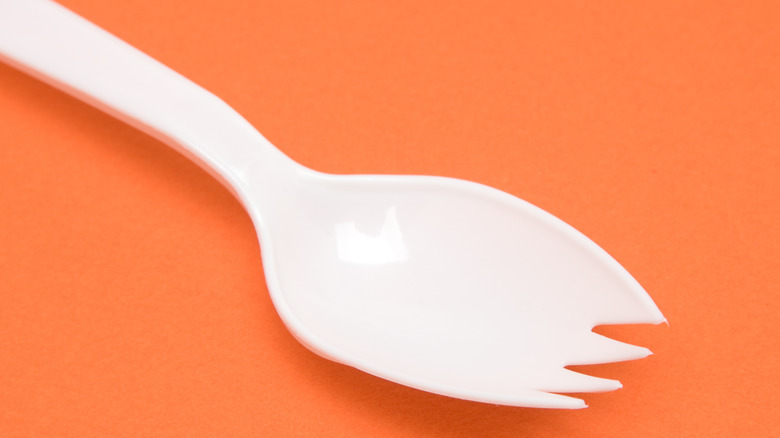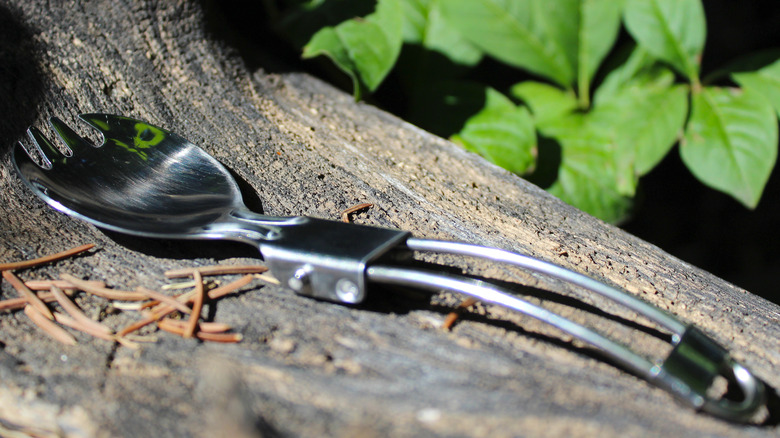There's Pretty Much No Difference Between Ice Cream Forks And Sporks
Who's ever heard of an ice cream fork? This unique utensil happens to be the traditional cutlery of choice for ice cream sundaes. Yet, distinctions to its modern-day equivalent, the spork, are virtually non-existent. Although the two utensils look the same and are capable of the same things, their difference is simply in their history and their names.
So, what is an ice cream fork? A utensil with the round curve of a spoon and shallow tines at the tip. Its tines allow it to puncture fresh fruit like the banana slices on a banana split, and its dual nature as a spoon allows it to scoop ice cream. The ice cream fork truly has the best of both worlds.
If a piece of cutlery with all of the benefits of both a fork and a spoon sounds pretty similar to the modern-day spork, it's because they are essentially the same tool. A "spork" gets its name from combining the words "spoon" and the word "fork." (Of course, some people argue it should be called a "fpoon.") The utensil reflects this multipurpose eating tool. Its spoon shape contains tines that allow you to pierce food or scoop it, as needed. Popular amongst backpackers and minimalists alike, no matter what you're eating or where you are, the spork is a safe bet to get the job done.
The history of the ice cream fork
The cultivation of ice cream as we know it — mixed salt and sweetened milk — started to take off in 17th–century Europe. The ice cream fork finds its origin in a time when fancy cutlery and innovative ice cream flavors were the norm. In fact, the biggest, most over-the-top ice cream flavors aren't a strictly modern invention, but a new take on a Georgian-era British trend.
By 18th–century England, the wealthy enjoyed ice cream at lavish feasts. For the middle classes, ice cream parlors grew in fashion. Flavors at the time ranged from ordinary to creative and included chocolate and pistachio, plus less-common varieties like pineapple, pine nut, and jasmine. They were sometimes served in elegant shapes formed using pewter molds; the frozen desserts were then garnished with natural food coloring and other visual elements that enhanced the display.
Alongside other unique cutlery, ice cream forks evolved as the art of entertaining evolved. The etiquette for elaborate banquets called for an ice cream fork. In this era, proper table settings moved past simple forks, knives, and spoons, and a host of niche utensils arose. These included snail forks and bonbon scoops. Ice cream forks were the utensil of choice for ice cream served on a plate.
The rise of the spork
The spork was invented in America as elegant cutlery was on the decline and practical utensils were on the rise. Rather than oyster forks and bouillon spoons, the fast-paced modern world was ready for a multi-purpose tool that did it all. The spork was trademarked in the 19th century. Its design had virtually all of the same components as the vintage ice cream fork, but its name boasted of so much more.
The spork could serve as a spoon or as a fork; the spork could be a one-stop utensil for whatever people ate. In some ways, the spork is simply the ice cream fork reimagined. The spork traded the ice cream fork's silver material for plastic. Rather than being a utensil for ice cream, the spork is available for use for virtually any dish! Its spread in popularity over the years has an interesting ally — fast food. Specifically, we have KFC to thank for the success of the spork.


